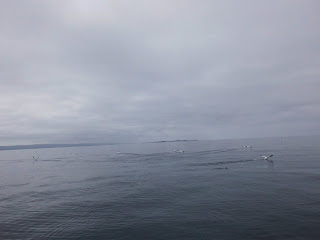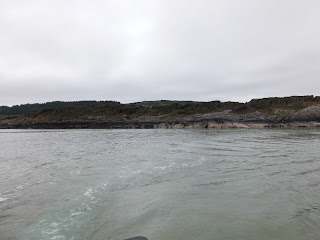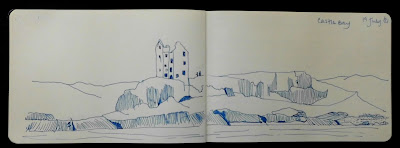 |
| Linnhe Marine |
Loch Linnhe, the southern end of the Great Glen, Scotland’s natural fault line is about 290 miles from home.
The journey was OK.
We were slowed drastically as we had to wait while a rather large motor
cruiser was manoeuvred into a marina on Loch Lomond but apart from that all was
well. We arrived tired and ready to rest
but that isn’t how sailing works.
First, we needed to bring EB to the pontoon, then bring all
our provisions, clothes and kitchen sink (not really) on board. Then we needed to put things away or away
enough to spend our first night in comfort.
Oh, and eat.
Bringing EB to the pontoon was straightforward. Nick who runs the family owned marine, took us out on the marine's work boat to where EB had been left on a floating mooring. The dinghy was heaved from the deck, over the side and into the water, fenders and lines were put in place and we were ready to release ourselves from the mooring. Floating moorings tend to consist of a large, anchored buoy with a smaller buoy attached by a floating rope. The smaller buoy is usually taken on board and its line helps secure the boat to the main buoy. To release this we needed to undo the line and push the smaller buoy back through the gap in the stanchions to release us. Think pushing very stiff jelly through the eye of a needle.
Loading was straightforward too. We loaded the marine’s trolleys with our gear
and rolled them down the pontoon to the boat.
Each item was then manhandled aboard and put somewhere out of the
way. It took two large trolleys and one
smaller one. By now tempers were getting
a little frayed.
Once everything was on board, one of us started doing boaty things whilst the other, who didn’t know where the lockers were never mind which lockers were for what, started to put things away. In addition, many of the lockers had things in them which needed to be sorted first and there’s a certain grubbiness about a boat when it’s been used on a passage as EB had. Niceties like a clean cutlery drawer go out the window or in this case porthole however that’s being picky, it was generally clean but when you’re tired and hungry you do get picky. Meanwhile my other half decided to help by being particularly impatient when he wanted an immediate answer to where to put things. I was tempted.
 |
| from the pontoon |
 |
| other half doing a boaty thing in the aft cabin - Loch Linnhe looking north east in the background |
 |
| our first sunset, about an hour later than the sunset at home |
The following day was a day of jobs. Mostly boaty jobs, finishing work and making small repairs after the boat's journey from home. The weather was glorious – sunny and still. There were moon jelly fish in the loch and at one time a shoal of mackerel. I spent most of the day familiarising myself with the boat and its many lockers and reorganising the items quickly stowed the previous day.
I came across bananas, never a good find on a boat. After sorting the cutlery drawer, where a sponge scourer had died, all was starting to look more ship-shape and felt more like home. We slept well, again. [On rereading this, I think I should say here, we slept well every night. The combination of full, active days, constantly being aware of our surroundings and sea air made sleep come quickly.]
The next day was an adventure. My other half had found a quiet inlet where I took my first swim of the holiday. The water felt like silk; beautifully refreshing and clear. It was just a quick dip this time to make sure I could get back on to the boat easily which in fact, turned out to be tricky however, we have a Plan B ready for next time. My watering can shower was perfect and after I had been in the loch it even felt warm.
After drying off and a smoked salmon sarnie we set off again
for Oban. There was no wind so no
sailing but the journey was pleasant enough on the motor. At one stage the sky and sea turned a slate
grey. As the sun shone through the
menacing clouds the light was extraordinary.
The brightness and whiteness of the wake of a passing motor craft looked
other worldly. Shining in the darkness. My photos don’t do it justice.
Approaching Oban was like revisiting an old friend. Nothing much had changed since our last visit
except the buoyage. Usually as you enter
a port, starboard is depicted by green markers or perches and port by red. Oban has marked the way we entered the other
way round. [more info is here]
Oban is a busy place. It’s a major hub for the island ferries, it has an active fishing fleet, it’s a busy turn-round port for cruises and it’s full of yachts, motor cruisers and any number of other craft and vessels which will take you to see seals, to fish or simply go extremely fast around Kerrera, the island opposite the town.
Oban also has supermarkets and a Wetherspoons. One to stock up on fresh food and the other to have a drink whilst you watch the ferries and trawlers. Incidentally, Wetherspoons name their pubs using a local point of reference, this one is called The Corryvrecken named after an area of water that has a complicated tidal flow which pushes over an underwater cliff edge. We have been through there more than once and it’s fascinating to see the swirls and eddies which are seemingly random. Adventure seeking swimmers have swum through it too. https://www.highlandopenwaterswim.com/corryvreckan/ Some folk are barmy.
After a very late start, we resorted to Plan B and stayed in
Oban another night leaving another day to explore the town, catch up on a
couple of jobs and… to watch England in the final of Euro 2020. Delayed from last year due to Coronavirus /
Covid 19. [We seem miles away from that
here although track & trace and wearing face coverings is still required in
shops etc.] England are playing Italy at
eight o’clock and EE have given my other half, free streaming access between
six and twelve. So it would be rude not
to. Fingers crossed.
 |
| plans are afoot for the next day |




































































